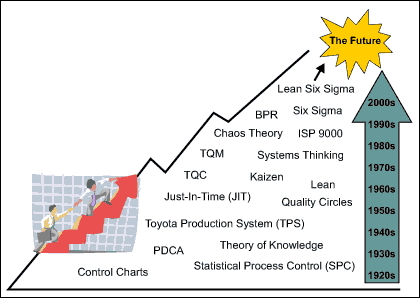Contributions to Six Sigma
We shall now elaborate the contributions to Six Sigma by various quality pioneers
Quality theory was developed by several key pioneers. Some of the most well-known pioneers are noted for their significant contributions towards development the foundation of Six Sigma which include – Joseph Juran, W. Edwards Deming, Walter Shewhart, Kaoru Ishikawa, and Genichi Taguchi.

Joseph Juran Contribution Contributions to Six Sigma
- Joseph Juran’s ideas were instrumental in the development of the total quality management, or TQM theory, well-known base for quality initiatives. His Quality Control Handbook, published in 1951 quickly became the reference for quality managers which remain the key reference even today.
- Juran influenced top management in its move to adopt Six Sigma and quality principles in Japan.
- He played a key role in developing the Japanese economy during the 1950s.
- His Institute also influenced top management in the U.S. just as he did in Japan.
- He also developed the Juran Trilogy for quality management, which consists of three basic principles – quality planning, quality control, and quality improvement.
Edwards Deming Contributions to Six Sigma
Edwards Deming was a leader in the field of statistical methods of quality control.
- He was influential to the Japanese, where he taught statistical methods to the member of the Union of Japanese Scientists and Engineers, referred to as JUSE. Deming became popular in the U.S. much later in his career when he proposed his 14 points and 7 deadly diseases of top management guidelines, such that these guidelines aim to create constancy in purpose. This means that an organization’s quality effort must be focused on a single goal. Deming’s most notable contributions was his support of the plan-do-study-act cycle as a method for system improvement. This method is still used today and is similar to other process improvement tools used in Six Sigma such as the DMAIC methodology.
Walter Shewhart Contributions to Six Sigma
Walter Shewhart was a pioneer who led the way for the use of statistics for quality management. Walter noticed, while he was working at Western Electric Company during the 1920s, that engineers needed to reduce the rate and occurrence of failures in order to improve the production processes and make them more economical.
- Walter described the problem of reducing errors in a process in terms of process variation, which is also the deviation from the mean called ‘Sigma’. He described process variation as one of two types – assignable cause and chance cause variation. Assignable cause variation is variation that can be traced back to a specific root cause. On the other hand, chance cause variation is variation that cannot be traced back to a specific cause. Such that the idea of reducing variation through the application of these statistical methods was the basis for statistical process control, or SPC. He was the first to use control charts to indicate where variation occurs within a process and then when we should act on it.
- Walter also made noteworthy contributions to the development of the plan-do-check-act cycle with Dr. Deming.
Ishikawa Contributions to Six Sigma
Dr. Kaoru Ishikawa also considered as the father of Japanese quality control. His contributions include –
- Ishikawa was able to distinguish the Japanese approach to total quality control, which he referred to as company-wide quality control, from the western style. His ideas are evident even today in quality management, such as the concept of quality circles and next operation as customer.
- Ishikawa’s major contributions to the development of quality management theory, and it’s the base for Six Sigma, is a development of the cause-and-effect diagram. The cause-and-effect diagram is a very simple method and graphic that’s used to identify root causes that are underlying process problems without the use of complicated statistics. The cause-and-effect diagram is also commonly referred to as Ishikawa diagram in his honor.
Dr. Genichi Taguchi
Dr. Genichi Taguchi also known as a father of quality engineering. Dr. Taguchi was instrumental in the process of developing quality engineering techniques to reduce cycle time, which is a large part of the Six Sigma process improvement methodology.
- Taguchi well-known for his theory that manufacturing processes are influenced by external factors that he referred to as ‘noise’.
- Taguchi said that in order to improve a process and reduce the costs that are involved, manager’s needs to identify and eliminate the noises from the process signal, because these are the vital elements of the process.

